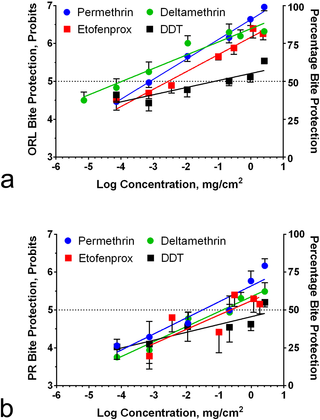PLOS Neglected Tropical Diseases ( IF 3.4 ) Pub Date : 2017-09-20 , DOI: 10.1371/journal.pntd.0005954 Natasha M Agramonte 1, 2 , Jeffrey R Bloomquist 1 , Ulrich R Bernier 2

|
Emerging insecticide resistance is a major issue for vector control. It decreases the effectiveness of insecticides, thereby requiring greater quantities for comparable control with a net increase in risk of disease resurgence, product cost, and damage risk to the ecosystem. Pyrethroid resistance has been documented in Puerto Rican populations of Aedes aegypti (L.) mosquitoes. In this study, topical toxicity of five insecticides (permethrin, etofenprox, deltamethrin, DDT, transfluthrin) was determined for susceptible (Orlando—ORL) and resistant (Puerto Rico—PR) strains of Ae. aegypti. Resistance ratios were calculated using LD50 values, and high resistance ratios for permethrin (112) and etofenprox (228) were observed for the Puerto Rico strain. Behavioral differences in blood-feeding activity for pyrethroid-resistant and pyrethroid-susceptible strains of Ae. aegypti when exposed to pyrethroid-treated cloth were also explored. Strains were exposed for 15 min to a range of concentrations of pyrethroid-treated uniform fabric in a cage that contained 60 female Ae. aegypti mosquitoes. Interestingly, the resistance ratios for blood-feeding were similar for permethrin (61) and etofenprox (70), but were lower than their respective resistance ratios for topical toxicity, suggesting that knockdown resistance was the primary mechanism of resistance in the blood feeding assays. Results showed a rightward shift in the dose-response curves for blood-feeding that indicated higher concentrations of pyrethroids were necessary to deter blood-feeding behavior in the pyrethroid-resistant Puerto Rican strain of Ae. aegypti.
中文翻译:

拟除虫菊酯耐药性改变了暴露于经过处理的织物的波多黎各埃及伊蚊的吸血行为
新出现的杀虫剂抗药性是病媒控制的一个主要问题。它降低了杀虫剂的有效性,因此需要更多的杀虫剂来进行类似的控制,从而导致疾病死灰复燃的风险、产品成本和生态系统破坏风险净增加。已在波多黎各的埃及伊蚊种群中记录了拟除虫菊酯耐药性。在这项研究中,测定了五种杀虫剂(氯菊酯、醚菊酯、溴氰菊酯、滴滴涕、四氟菊酯)对伊蚊敏感株(奥兰多—ORL)和抗性株(波多黎各—PR)的局部毒性。埃及伊蚊。使用LD 50值计算耐药率,并且观察到波多黎各菌株对氯菊酯(112)和依托芬菊(228)的高耐药率。拟除虫菊酯抗性和拟除虫菊酯敏感菌株的吸血活性行为差异。还对暴露于拟除虫菊酯处理过的布料时的埃及伊蚊进行了研究。将菌株置于含有 60 只雌性白鹳的笼子中,在一系列浓度的拟除虫菊酯处理的均匀织物中暴露 15 分钟。埃及蚊子。有趣的是,氯菊酯 (61) 和依托芬菊 (70) 的吸血耐药率相似,但低于各自的局部毒性耐药率,表明击倒耐药性是吸血试验中耐药的主要机制。结果显示,吸血的剂量反应曲线向右移动,这表明需要更高浓度的拟除虫菊酯来阻止对拟除虫菊酯具有抗性的波多黎各伊蚊菌株的吸血行为。埃及伊蚊。











































 京公网安备 11010802027423号
京公网安备 11010802027423号